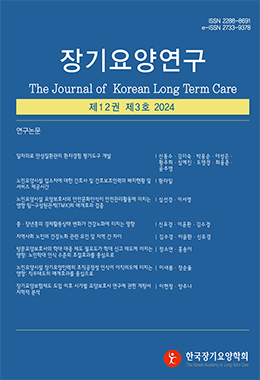본 연구목적은 노인요양시설의 간호사 및 간호보조인력 배치현황과 입소자 1인당 서비스 제공시간을 분석함으로써, 향후 안전하고 품질높은 서비스 제공에 필요한 인력 배치기준을 마련하는데 있다. 본 연구자료는 노인장기요양 홈페이지에 탑재된 전국의 노인요양시설 전수의 기관현황, 종사인력 현황 등을 토대로 SPSS통계프로그램을 이용하여 분석하였다. 본 연구결과 노인요양시설 중 간호사가 배치되어 있는 시설은 4곳 중 1곳에 불과하였고, 노인요양시설 규모가 크고, 10년 이상 운영 시설이며, 치매전담실 설치 시설과 시설평가등급이 높은 시설의 경우 간호사 배치율이 높게 나타났다. 노인요양시설에 근무하는 간호사 및 간호보조인력의 40% 이상은 1년 이내 근무기간으로 이직률이 높은 수준인 것으로 분석되었다. 한편 간호사 및 간호보조인력 총서비스 제공시간과 간호보조인력의 서비스 제공시간은 미국과 유사한 수준이지만 간호사 서비스 제공시간은 매우 낮게 나타나 비전문인력이 제공하는 서비스시간이 많음을 확인하였다. 특히, 농어촌 지역 설립, 소규모, 기관평가등급이 낮은 시설에서 간호사 서비스 제공시간이 낮게 나타나, 전문적 보건의료서비스를 제공할 간호사 배치 지원방안 마련이 필요함을 확인하였다. 본 연구 한계상 입소자 특성에 따른 간호사와 간호보조인력 배치수준 차이에 대한 자료분석이 이루어지지 못했으므로, 향후 입소자 특성별로 간호사 및 간호보조인력이 실질적으로 제공하는 서비스시간 분석을 토대로 노인요양시설 내 인력 배치기준안을 마련하는 연구와 인력 배치가 서비스 품질에 미치는 효과를 평가하는 추가적 연구가 필요함을 제언한다.
Purpose: This study identifies the deployment status of registered nurses (RNs) and nursing assistants in nursing homes and the daily nursing staffing hours (HPRD) per resident. Methods: This study used data such as the current status of institutions in charge of elderly care facilities across the country, the Status of employees, etc. posted on the Korea Long-Term Care homepage and analyzed them using the SPSS statistical program.
Results: Only one out of four nursing homes deployed RN, Large-scale, those in operation for more than 10 years, those with specialized dementia programs, and those with high facility evaluation ratings deployed RNs. More than 40% of registered nurses and nursing assistants working in nursing homes had worked for less than 1 year, showing a high turnover rate. The HPRD of nursing assistants in nursing homes was similar to that of developed countries. However, the HPRD of RNs was very low, confirming that non-specialists provided many service hours. In particular, nursing homes in rural areas, small-scale, and those with low institutional evaluation ratings had low HPRD of RNs. Conclusions: The legal standards for mandating the placement of RNs in nursing homes should be strengthened, and institutional measures to support the deployment of nurses are needed.




